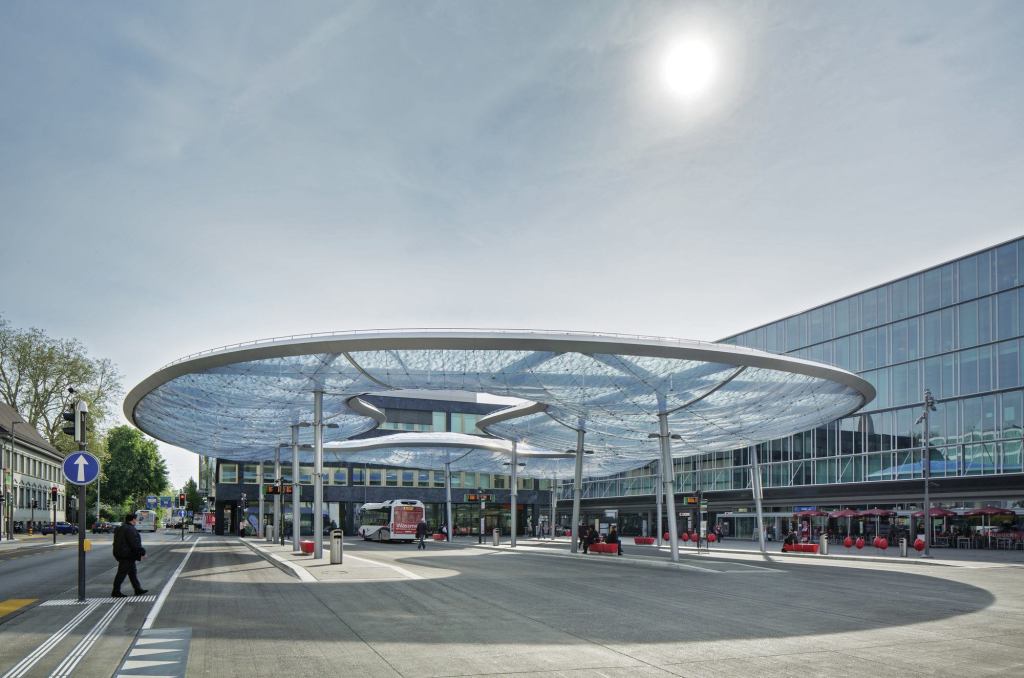A cloud hangs over the heads of visitors to the bus station on the bustling Bahnhofstrasse main street in Aarau, Switzerland. But rather than signaling the onset of precipitation, this cloud is a protective, air-filled membrane—and the world’s largest, single-chamber ethylene tetrafluoroethylene (ETFE) structure.
Designed by Zürich, Switzerland–based firm Vehovar & Jauslin Architektur (VJA), the translucent canopy maintains an airy feel. Sunlight streaming through a pattern printed on the membrane’s colorless bottom ply and blue-tinted top ply create the dappling effect of light filtering through trees. The lower ply’s pattern is subtle, revealing the structure’s internal framing from below, while the upper pattern is denser to reflect light pollution at night. And at the center of the canopy, the sky is visible through a sinuous oculus, which VJA partner and co-founder Mateja Vehovar says was designed to mimic a clearing in the woods.
The organic shape of the 1,080-square-meter (11,625-square-foot) canopy would have been difficult to achieve with a material other than ETFE, which can be manipulated like cloth when deflated. Vehovar says that a comparable glass roof would be 75 times heavier and require a much stronger support structure. VJA also chose ETFE, supplied by Nowofol in Siegsdorf, Germany, for its durability, weather resistance, and ability to self-clean.
![]()
To maintain the membrane’s normal working air pressure of 300 pascals (0.044 pounds per square inch), an air-control unit pumps filtered, dehumidified air through a network of tubes under the pavement and into the membrane before it circulates back again.
Sensors on the closed-circuit system monitor and automatically adjust the air pressure, which can increase to 850 pascals (0.12 pounds per square inch) in the case of extreme snow accumulation, says Stefan Jauslin, VJA partner and co-founder. Mechanical ventilation controls the airflow to keep the air within the membrane dry and to prevent condensation. Under normal weather conditions, the air-filled membrane measures up to 3.6 meters (11.8 feet) thick.
![]()
A freeform frame, which combines galvanized steel members of varying shapes and sizes, and an irregular network of steel cables support the canopy. Aluminum clamps connect the 250-micrometer-thick membrane to the frame, which also houses the utility lines for the canopy’s drainage, lighting, and air circulation systems.
Creating an airtight frame around the membrane was challenging. Engineering firm FormTL, based in Radolfzell, Germany, used Autodesk Inventor 3D CAD software and other form-finding tools to design the canopy down to the last screw. “In this way, the surprises on the site during construction [were] reduced to almost none, and the construction’s precision [was] much better than required by quality norms,” Vehovar says.
![]()
The structure was mocked up in a factory in Bremen, Germany, and then dismantled and transported to Aarau in the summer of 2012. The frame was erected first, and then the membrane was attached to the frame in three pieces, which were joined together by aluminum clamps with butylene seals before being inflated like a beach ball. The structure was completed in June 2013.
While an air-filled structure may sound temporary, the canopy is actually a permanent fixture of the new bus station. Maintaining it simply requires workers to check the ventilation system and clean the air filters annually.
Besides providing shelter, the canopy is intended to be a landmark and captivating piece of art. “The roof is a signal in the urban fabric,” Vehovar says.
